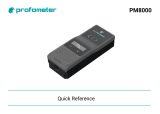
2
All Rights Reserved
Printed in the USA
2001 by The Toro Company
8111 Lyndale Avenue South
Bloomington, MN 55420-1196
Contents
Page
Introduction 2. . . . . . . . . . . . . . . . . . . . . . . . . . . . . . . .
Safety 2. . . . . . . . . . . . . . . . . . . . . . . . . . . . . . . . . . . . .
Sound Power 3. . . . . . . . . . . . . . . . . . . . . . . . . . . .
Sound Pressure 3. . . . . . . . . . . . . . . . . . . . . . . . . . .
Safety and Instruction Decals 4. . . . . . . . . . . . . . . .
Specifications 4. . . . . . . . . . . . . . . . . . . . . . . . . . . . . . .
Stability Ratings 5. . . . . . . . . . . . . . . . . . . . . . . . . .
Installation 5. . . . . . . . . . . . . . . . . . . . . . . . . . . . . . . . .
Installing the Bit 5. . . . . . . . . . . . . . . . . . . . . . . . . .
Operation 5. . . . . . . . . . . . . . . . . . . . . . . . . . . . . . . . . .
Operating Tips 5. . . . . . . . . . . . . . . . . . . . . . . . . . .
Breaking a Vertical Surface 6. . . . . . . . . . . . . . . . .
Maintenance 7. . . . . . . . . . . . . . . . . . . . . . . . . . . . . . . .
Service Interval Chart 7. . . . . . . . . . . . . . . . . . . . . .
Greasing the Bit 8. . . . . . . . . . . . . . . . . . . . . . . . . .
Charging the Nitrogen 8. . . . . . . . . . . . . . . . . . . . .
Storage 9. . . . . . . . . . . . . . . . . . . . . . . . . . . . . . . . .
Troubleshooting 9. . . . . . . . . . . . . . . . . . . . . . . . . . . . .
Introduction
We want you to be completely satisfied with your new
product, so feel free to contact your Authorized Service
Dealer for help with service, genuine replacement parts, or
other information you may require.
Whenever you contact your Authorized Service Dealer or
the factory, always know the model and serial numbers of
your product. These numbers will help the Service Dealer
or Service Representative provide exact information about
your specific product. You will find the model and serial
number on a plate located on the breaker frame.
For your convenience, write the product model and serial
numbers in the space below.
Model No:
Serial No.
The warning system in this manual identifies potential
hazards and has special safety messages that help you and
others avoid personal injury, even death. DANGER,
WARNING and CAUTION are signal words used to
identify the level of hazard. However, regardless of the
hazard, be extremely careful.
DANGER signals an extreme hazard that will cause
serious injury or death if the recommended precautions are
not followed.
WARNING signals a hazard that may cause serious injury
or death if the recommended precautions are not followed.
CAUTION signals a hazard that may cause minor or
moderate injury if the recommended precautions are not
followed.
Two other words are also used to highlight information.
“Important” calls attention to special mechanical
information and “Note” emphasizes general information
worthy of special attention.
The left and right side of the machine is determined by
standing in the normal operator’s position.
Safety
Completely read this manual and the traction unit
operator’s manual before using the equipment. Also,
ensure that anyone who will use the equipment has read
these manuals or has been fully trained in the safety and
proper usage of the equipment by someone who has
read them.
Improper use or maintenance by the operator or owner
can result in injury. To reduce the potential for injury,
comply with the safety instructions in the traction unit
operator’s manual and always pay attention to the
safety alert symbol, which means CAUTION,
WARNING, or DANGER—“personal safety
instruction.” Failure to comply with the instruction may
result in personal injury or death.
Danger
There may be buried power, gas, and/or telephone
lines in the work area which may explode or shock
you if you dig into them.
Have the property or area to be broken marked
for buried lines and do not break in marked areas.














